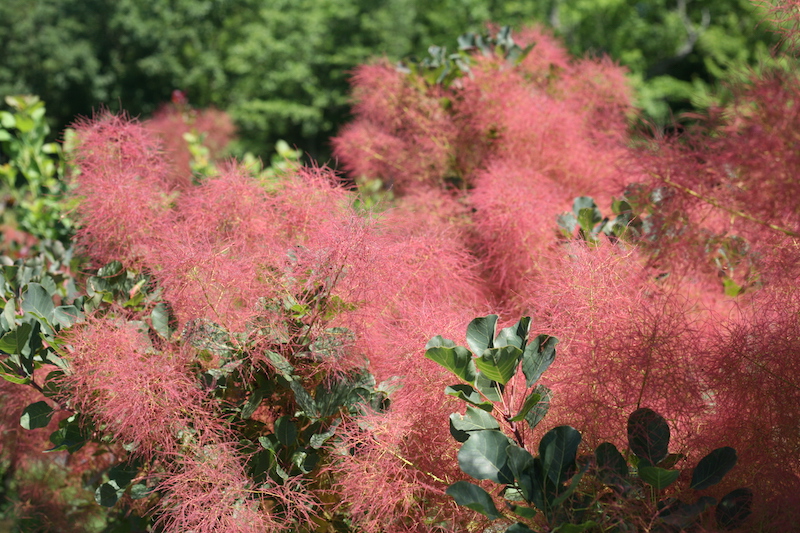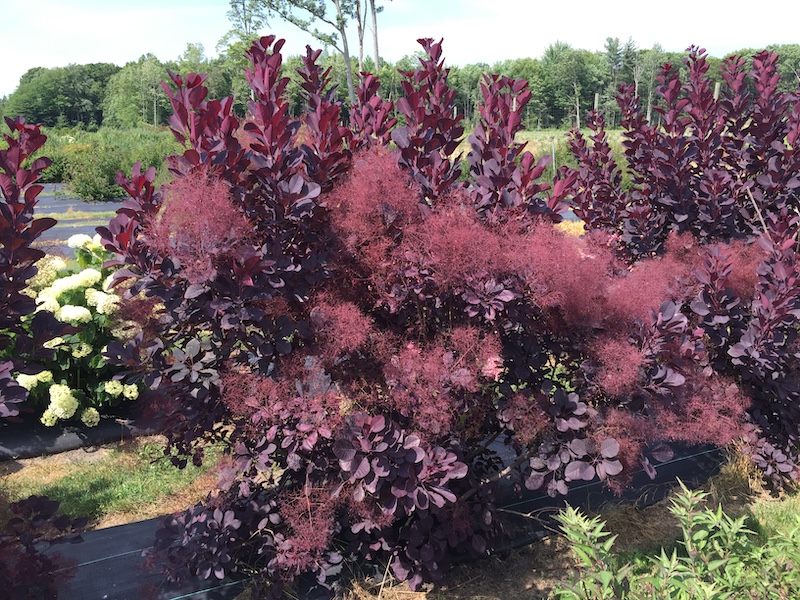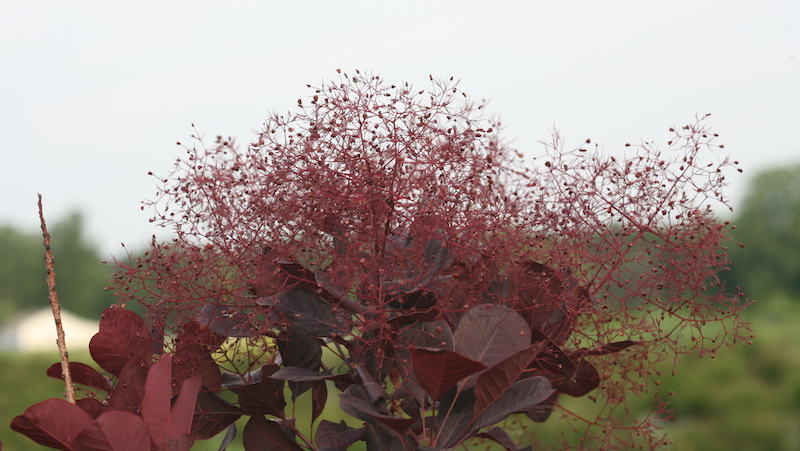Growing Smoke Tree
With its vibrant leaves and unique, eye-catching wisps for flowers, the Smoke Tree (Cotinus spp.) makes a statement in any sunny landscape. Smoke Trees can come in a variety of sizes, from dwarf bushes 2-3 feet tall to tree-sized, towering around 12 feet tall. The blooms are what truly make this plant special. From spring to late summer, the Smoke Tree blooms, producing large tufts of fuzzy, smoke-like flowers, making the tree look like it has a plume of pinkish smoke emerging from its branches. Even out of bloom, the Smoke Tree is stunning with its rounded leaves. Depending on the variety, Smoke Trees can vary in color, usually starting the growing season with deep burgundy and purple leaves that may fade to green before putting on a show of oranges and bright reds in the fall.
With showy spring/summer blooms and unique fall foliage, these deciduous shrubs can be planted as specimens or grouped in privacy screens or hedges. Hardy in zones 5 to 8 and drought tolerant, Smoke Trees tolerate poor soils and are disease resistant. These ornamental shrubs grow moderately fast and are easy to care for, making them smart options when searching for plants offering a lot of color with minimal risk.

Two common species of Smoke Tree are Cotinus coggygria, or Common Smoke Tree, and Cotinus obovatu, or American Smoke Tree. Cotinus coggygria, a native of North America, reaches a maximum height and spread of 10 to 15 feet and possesses pink florets in summer, followed by showy fall foliage that is either green or claret. Cotinus obovatu, a native of the Southeastern United States, grows to a maximum height and spread of 20 to 30 feet and is characterized by pink and purple summer flowers followed by striking magenta, apricot, crimson, and marigold foliage during the fall. Both species are commonly incorporated into landscapes as shrubs or small trees.
Planting Smoke Tree
When planting a Smoke Tree, it is important to choose a location that will allow your tree to grow to its full size. Smoke Tree produces more brilliant foliage color when afforded at least 6 hours of full sun. This adaptable plant tolerates various soils as long as they drain well. Dig a hole about two times as wide and a little deeper than the root ball and cover the root ball with the native soil. If your soil is of poor quality or clay-y, it is a good idea to amend it with soil conditioner, garden soil, or compost to improve drainage. Water in the roots well and add a 2-inch layer of mulch around the dripline to conserve moisture. Plant the shrub with sneezeweed, rudbeckia, and Russian sage for a stunning combination.

Watering Smoke Tree
One great benefit of Smoke Trees is that they are drought tolerant once established. In the plant’s first year in your garden, however, it is a good idea to water the tree regularly to help encourage healthy, deep roots. After planting, water your new Smoke Tree deeply twice a week in the summer, allowing water to seep at least 8 inches into the soil. Once established, Smoke Trees can handle periods of drought, though it is a good idea to water at least once a week in drier times. Adding a couple inches of mulch around the base of the plant will help slow evaporation and prevent dehydration during the hot summer months. Cotinus obovatu prefers drier soil than Cotinus coggygria, so make sure not to overwater this species.
Fertilizing Smoke Tree
While young Smoke Trees can benefit from fertilizing in the spring, established trees do not require much in terms of fertilizer. To jumpstart slow growers, apply a slow-release, all-purpose, granular fertilizer in the early spring as the Smoke Bush begins producing leaves. A light feeding will encourage additional development of the leaves and stems. Rich compost applied in the early spring can also benefit Smoke Trees.
Pruning Smoke Tree
Like other moderate-sized trees, it is important to plant the Smoke Tree in a spot where it can grow to its full size. Depending on the variety, these trees can grow quite wide, though their shape can be controlled with early spring pruning. If you wish to keep your Smoke Bush looking more tame, remove dead branches and those crossing into the center of the plant in the late winter/early spring before leaves emerge.
Keep in mind that Smoke Trees bloom on old wood, and pruning will impact blooming. By pruning Smoke Trees, you are removing that year’s bud sites. If your Smoke Tree is in serious need of shaping and rejuvenating and you are willing to sacrifice all the blooms for a year, you can cut all branches back to about 6-8 inches from the ground. Hard pruning results in larger, showier foliage, and some gardeners remove the flower buds on purpose to avoid cleaning up messy flower litter later in the season.

Caring For Smoke Tree in Pots
Despite their large size, Smoke Trees can do surprisingly well in pots. Smoke Tree’s showy flowers and foliage enhance patios, porches, and decks when grown in containers. The trick is finding a quality pot with drainage holes and filled with well-draining potting soil. When choosing a pot for your Smoke Tree, it is important not to put a small root ball in a large pot, even if the tree will eventually grow to be quite large. Instead, start by putting your Smoke Tree into a pot that is only 2 to 4 inches larger than its root ball, and gradually size up every year or two once the roots are ready for a larger pot. Because Smoke Trees can become quite top-heavy, choose heavier pots with a sturdy base to prevent tipping.
Place the container in a sunny location and water your potted Smoke Tree regularly until established. Then, reduce watering to about once a week when the soil dries out. Plant this shrub with verbena and yarrow for a knockout summer combination. Keep in mind that plants in pots are exposed to the elements more, so regularly check on the health of your plant and protect the roots from extreme winter cold.
Winter Care for Smoke Tree
Smoke Trees are deciduous, meaning they will lose their leaves in the winter and go dormant, needing little care. In the fall, continue to water but do not fertilize this shrub. Smoke Trees are cold hardy in zones 5-8, making them suitable for many regions that experience cold winters. To better protect the roots, apply a few inches of mulch around the base of the tree.
If keeping your Smoke Tree in a pot, move the pot into a protected garage or basement in the winter to protect the roots from freezing. You can also wrap the container with hardware cloth to protect it from freeze-thaw cycles. You can use chicken wire, a wire basket, or wire fencing for protection against critters.
 |
Author Suellen Barnes - Published 2-26-2023 |
